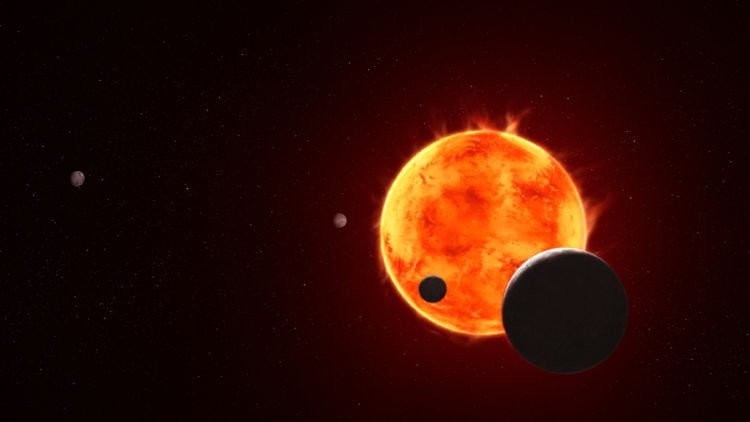Science
Scientists Explore Microbial Life Biosignatures in Exoplanet Clouds

Research teams are investigating the potential for identifying microbial life in the atmospheres of exoplanets. A recent manuscript submitted by a group of scientists aims to explore how biosignatures of airborne microbes could be detected in the clouds of distant worlds. This innovative study may significantly enhance the methods used to search for life beyond Earth.
The researchers conducted laboratory experiments using seven microbial strains sourced from Earth’s atmosphere. These included strains such as Modestobacter versicolor, Roseomonas vinacea, and Micrococcus luteus, among others. By employing spectroscopy, the team analyzed the light reflected by these samples, seeking to determine if their spectral features could serve as reliable indicators of biosignatures in exoplanetary atmospheres.
Each microbial sample demonstrated unique spectral signatures that could be utilized to identify them in the clouds and atmospheres of exoplanets. The study concluded that “we present an additional path for searching for life on Earth-like exoplanets: the search for biopigments as signs of life in clouds.” These findings provide a crucial spectral reference for future missions, enabling scientists to detect and interpret potential biosignatures in the light reflected from Earth-like exoplanets.
Historical Context and Future Missions
The motivation behind this research is rooted in previous studies, such as one conducted in 1976 by American astronomer Dr. Carl Sagan and Australian-American astrophysicist Dr. Ed Salpeter. They hypothesized about the existence of life in Jupiter’s clouds, proposing four types of organisms that could inhabit its atmosphere. Their work laid the groundwork for exploring similar possibilities on exoplanets.
Another significant motivation for the current study is the planned Habitable Worlds Observatory (HWO), a space telescope set to launch in the 2040s. HWO aims to analyze 25 habitable exoplanets for biosignatures, utilizing spectroscopy to advance our understanding of potential life beyond our solar system. Alongside these planetary studies, HWO will also investigate galaxy formation, star evolution, and solar system objects.
The James Webb Space Telescope (JWST) has already made strides in this domain by examining several exoplanet atmospheres, including WASP-39 b and WASP-17 b. Located approximately 700 and 1,324 light-years from Earth, respectively, JWST identified components such as water, carbon dioxide, and carbon monoxide in WASP-39 b’s atmosphere. In contrast, quartz particles were discovered at high altitudes in the atmosphere of WASP-17 b.
Recently, JWST focused on the atmosphere of TRAPPIST-1 e, an Earth-sized exoplanet located around 41 light-years away. Although the findings published in The Astrophysical Journal did not confirm the presence of a substantial atmosphere, they highlighted the need for further research to clarify the conditions surrounding this intriguing planet.
Implications for Astrobiology
The current study opens a new frontier in the search for extraterrestrial life, suggesting that clouds could serve as viable environments for observable life-supporting ecosystems on exoplanets. This paradigm shift may lead to innovative strategies for astrobiological exploration and discovery.
As researchers continue to refine their techniques and expand their investigations, the quest to uncover life in exoplanetary atmospheres remains a thrilling and dynamic field. The integration of microbial biosignatures in this search may enhance our understanding of life’s potential beyond Earth and drive future scientific missions.
The implications of this research are profound, as it could revolutionize our approach to astrobiology. As scientists continue to explore the cosmos, the search for life in exoplanet atmospheres and clouds is set to become an increasingly pivotal aspect of astronomical studies.
-

 Lifestyle3 months ago
Lifestyle3 months agoLibraries Challenge Rising E-Book Costs Amid Growing Demand
-

 Sports3 months ago
Sports3 months agoTyreek Hill Responds to Tua Tagovailoa’s Comments on Team Dynamics
-

 Sports3 months ago
Sports3 months agoLiverpool Secures Agreement to Sign Young Striker Will Wright
-

 Lifestyle3 months ago
Lifestyle3 months agoSave Your Split Tomatoes: Expert Tips for Gardeners
-

 Lifestyle3 months ago
Lifestyle3 months agoPrincess Beatrice’s Daughter Athena Joins Siblings at London Parade
-

 World3 months ago
World3 months agoWinter Storms Lash New South Wales with Snow, Flood Risks
-

 Science3 months ago
Science3 months agoTrump Administration Moves to Repeal Key Climate Regulation
-

 Business3 months ago
Business3 months agoSoFi Technologies Shares Slip 2% Following Insider Stock Sale
-

 Science2 months ago
Science2 months agoSan Francisco Hosts Unique Contest to Identify “Performative Males”
-

 Science3 months ago
Science3 months agoNew Tool Reveals Link Between Horse Coat Condition and Parasites
-

 Sports3 months ago
Sports3 months agoElon Musk Sculpture Travels From Utah to Yosemite National Park
-

 Science3 months ago
Science3 months agoNew Study Confirms Humans Transported Stonehenge Bluestones









